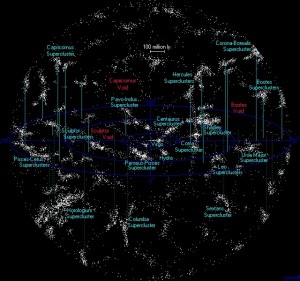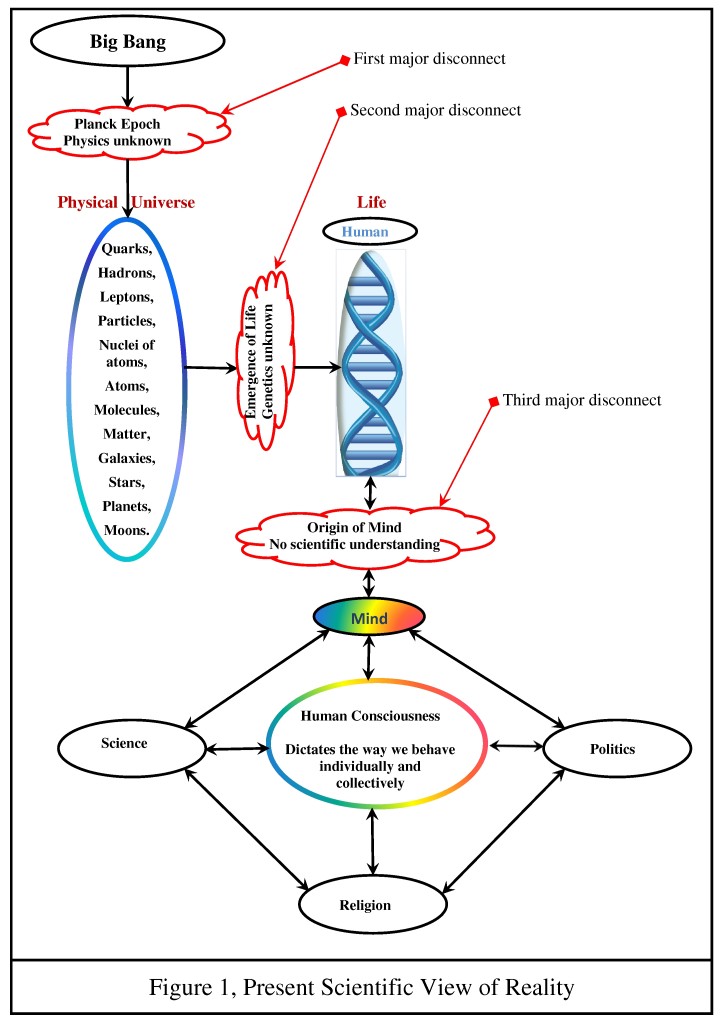The language of physics is mathematics, which can only describe the physical universe1. In other words, mathematics must have something (some ‘thing’) to describe – a particle, a wave, a vibration, a string, a membrane etc. Einstein once said: “So far as the theories of mathematics are about reality, they are not certain; so far as they are certain, they are not about reality.”
Mathematics, therefore, cannot describe the non-physical2 or pre-particle state – and logically there must be a pre-particle state. Scientists estimate that the universe is made up of 4 per cent ordinary matter, 26 per cent dark matter, and 70 per cent dark energy. (These figures may vary somewhat depending on the source.) It’s a sobering thought that, despite the vast amount of knowledge that scientists have regarding the universe, they only understand (and mathematics can only describe), at most, 4 percent of the whole – the remainder, I believe, is non-physical.
Many scientists now accept that the universe started with the ‘Big Bang’, the primeval explosion that brought all space and time, all matter and energy, into being. The concept of the Big Bang is based on the mindset that the universe is purely a physical phenomenon. However, for four primary reasons, this model regarding the origin of the universe makes little sense.
Reason 1
In 1927, Georges Lemaître published a virtually unnoticed paper that provided a compelling solution to the equations of General Relativity for the case of an expanding universe. Later, Lemaître explored the logical consequences of an expanding universe and proposed that it must have originated at a finite point in time. If the universe is expanding, he reasoned, it was smaller in the past, and extrapolation back in time should lead to an epoch when all the matter in the universe was packed together in an extremely dense state. Appealing to the new quantum theory of matter, Lemaître argued that the physical universe was initially a single particle—the “primeval atom” as he called it—which disintegrated in an explosion, giving rise to space and time and the expansion of the universe that continues to this day. This idea marked the birth of what we now know as Big Bang cosmology.
However, scientists now know that massive black holes exist at the centre of many, if not all, galaxies. Therefore, if the universe started to contract from its present state, it is logical to suggest that the black hole state would start to dominate long before the universe could contract back to the ‘primeval atom’. In fact, it is reasonable to suggest that at some point in the contraction process, all black holes would unite into one super massive black hole which would then ‘suck in’ the complete physical universe. This logic suggests that the source of the physical universe is the black hole state.
Reason 2
I believe that for any ‘live system’ to exist it must obviously have a source, but critically, that source must continue to play a role for the lifetime of the system by interacting with it, and renewing it on a continuous basis.
A simple analogy to explain this principle is the water cycle. Without getting too complex, the water cycle can be simply explained as follows; water vapour evaporates from the sea and fills the entire atmosphere. When conditions allow, this water vapour condenses to form clouds and the clouds then fall back to the sea as rain. In this analogy, the sea is the source, the water vapour is the non-physical (pre-particle) ‘stuff’ and the clouds are the physical universe. Now, if the sea had completely evaporated in its effort to make the clouds, then the cycle would break down and the system would die.
However, the Big Bang theory requires that the primeval atom (the source) is completely ‘used up’ in the act of creating the universe and therefore ceases to exist as a source. In my view that is completely illogical.
Reason 3
The Big Bang model predates scientists’ realisation that dark energy and probably dark matter exist, so it must be based on a purely physical universe, which is only 4 per cent of the whole. To suggest that the origin of the universe is based on 4 per cent of reality makes little sense.
Reason 4
Scientists believe that all four forces were united in the Planck epoch. If the four forces became united at the present time, there would be no gravity to keep all the celestial bodies in existence, there would be no electromagnetic force to bind atoms and molecules, and there would be no strong force to bind the elementary particles or to bind the nuclei of atoms. Therefore, all matter would return to elementary particles, such as electrons and quarks. The elementary particles would then return to the ‘stuff’ that existed in the Planck epoch, which would then account for 100 per cent of the ‘whole’.
However, there is no logical argument to suggest that the ‘stuff’ of the Planck epoch would then return to an infinitesimally small sphere. In my view the concept of this ‘infinitesimally small sphere’ is rooted in the belief that the universe is a purely physical phenomenon. However, since scientists now believe that only 4 per cent of the universe is physical, I believe that we should look to the 96 per cent, rather than the 4 per cent, to understand the origin of the universe.
Additionally, I believe in the old adage which states; ‘if something looks wrong it usually is wrong’. There are many aspects of Figure 1 below which look wrong, for example:
- There are three major disconnects which, on their own, should be sufficient to cast doubt over the integrity of the ‘whole system’
- There are many ‘one way’ arrows, implying there is not a continuous cycle of emanation, manifestation, and return as explained in Reason 2 above
- Life is only influenced by one source. In my blog dated 12th Nov 2014 I gave valid reasons why life must be influenced by two sources in order to exist.
Finally, in my blog dated 28th Nov 2014, I describe an alternative scientific view of reality which is infinitely more logical that that shown in Figure 1 above.
Footnotes
- Physical (or physical universe) can be defined as all forms of matter, energy, and momentum, and the physical forces, laws, and constants that govern them.
- Non-physical (or non-physical universe) can be defined as everything other than the physical. The non-physical can be viewed as pre-physical or pre-particle – in other words, the state that existed (and still exists) before elementary particles emerged. I believe that both dark matter and dark energy are non-physical which means the physical state only accounts for 4% of reality.
Recent Posts
- Scientific Support for Brexit July 5, 2018
- The Evolution of Human Consciousness November 12, 2015
- Will Science Retreat into a Cul de Sac – just as Theology did before them? September 22, 2015
- Corruption and Abuse of Power are the Source of all the Major Problems in our World September 9, 2015
- A United Europe. Is it a crazy idea? – or – Is it a necessary step in the evolutionary journey of the human race? August 11, 2015
- A New Scientific View of Reality based on The Grand Interactive Model June 9, 2015
- Humanity can create a world dominated by Love, Care, and Compassion April 13, 2015
- The Origin and Evolution of the Universe – The Grand Interactive Model November 28, 2014
- The roles science and theology have played in creating our present world of pain and suffering November 25, 2014
- Science and Theology – A Common Understanding November 18, 2014
Archives
- July 2018 (1)
- November 2015 (1)
- September 2015 (2)
- August 2015 (1)
- June 2015 (1)
- April 2015 (1)
- November 2014 (6)
- October 2014 (6)
- July 2014 (1)





Recent Comments